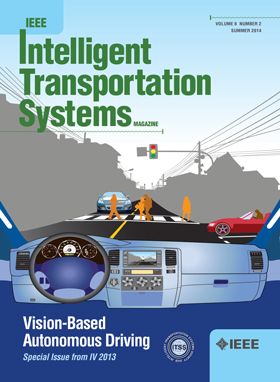A Survey and Framework of Cooperative Perception: From Heterogeneous Singleton to Hierarchical Cooperation
IF 7.9
1区 工程技术
Q1 ENGINEERING, CIVIL
IEEE Transactions on Intelligent Transportation Systems
Pub Date : 2024-09-30
DOI:10.1109/TITS.2024.3436012
引用次数: 0
Abstract
Perceiving the environment is one of the most fundamental keys to enabling Cooperative Driving Automation, which is regarded as the revolutionary solution to addressing the safety, mobility, and sustainability issues of contemporary transportation systems. Although an unprecedented evolution is now happening in the area of computer vision for object perception, state-of-the-art perception methods are still struggling with sophisticated real-world traffic environments due to the inevitable physical occlusion and limited receptive field of single-vehicle systems. Based on multiple spatially separated perception nodes, Cooperative Perception (CP) is born to unlock the bottleneck of perception for driving automation. In this paper, we comprehensively review and analyze the research progress on CP, and we propose a unified CP framework. The architectures and taxonomy of CP systems based on different types of sensors are reviewed to show a high-level description of the workflow and different structures for CP systems. The node structure, sensing modality, and fusion schemes are reviewed and analyzed with detailed explanations for CP. A Hierarchical Cooperative Perception (HCP) framework is proposed, followed by a review of existing open-source tools that support CP development. The discussion highlights the current opportunities, open challenges, and anticipated future trends.合作感知的调查与框架:从异质单体到分层合作
感知环境是实现自动协同驾驶的最根本关键之一,而自动协同驾驶被认为是解决当代交通系统的安全性、机动性和可持续性问题的革命性解决方案。尽管目前计算机视觉在物体感知领域取得了前所未有的发展,但由于单车系统不可避免的物理遮挡和有限的感受野,最先进的感知方法在复杂的现实世界交通环境中仍然举步维艰。基于多个空间上分离的感知节点,合作感知(CP)应运而生,以解开自动驾驶的感知瓶颈。本文全面回顾和分析了 CP 的研究进展,并提出了统一的 CP 框架。本文综述了基于不同类型传感器的 CP 系统架构和分类方法,对 CP 系统的工作流程和不同结构进行了高层次的描述。我们回顾并分析了节点结构、传感模式和融合方案,并对 CP 进行了详细解释。提出了分层合作感知(HCP)框架,随后回顾了支持 CP 开发的现有开源工具。讨论强调了当前的机遇、公开挑战和预期的未来趋势。
本文章由计算机程序翻译,如有差异,请以英文原文为准。
求助全文
约1分钟内获得全文
求助全文
来源期刊

IEEE Transactions on Intelligent Transportation Systems
工程技术-工程:电子与电气
CiteScore
14.80
自引率
12.90%
发文量
1872
审稿时长
7.5 months
期刊介绍:
The theoretical, experimental and operational aspects of electrical and electronics engineering and information technologies as applied to Intelligent Transportation Systems (ITS). Intelligent Transportation Systems are defined as those systems utilizing synergistic technologies and systems engineering concepts to develop and improve transportation systems of all kinds. The scope of this interdisciplinary activity includes the promotion, consolidation and coordination of ITS technical activities among IEEE entities, and providing a focus for cooperative activities, both internally and externally.
 求助内容:
求助内容: 应助结果提醒方式:
应助结果提醒方式:


